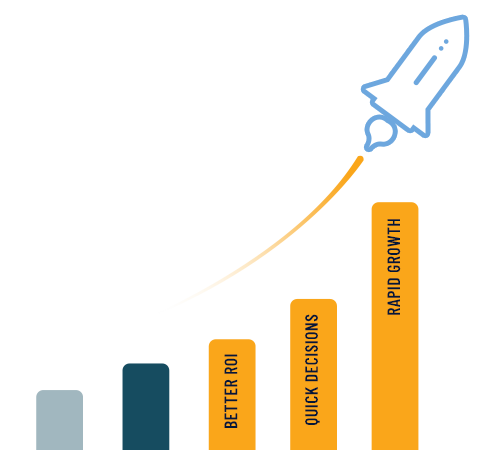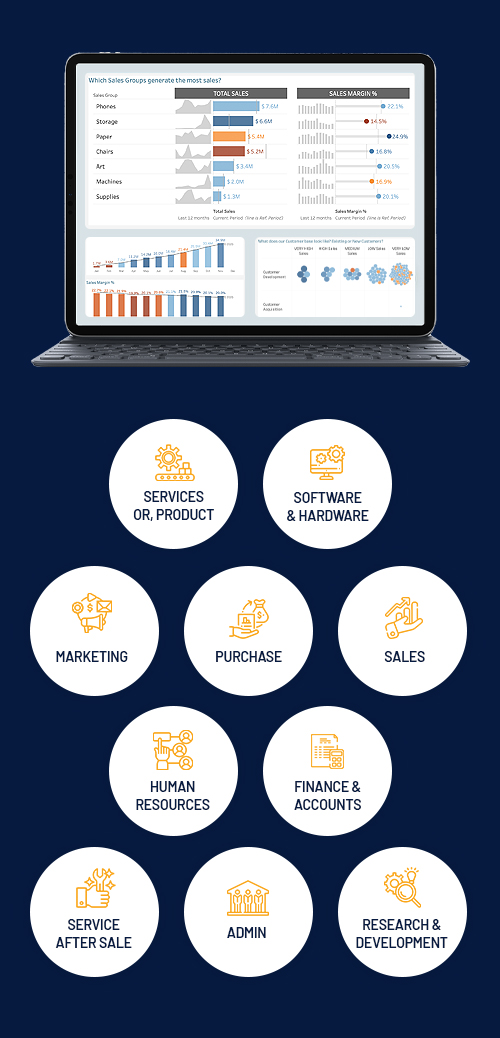
Achieve
UNIMAGINABLE
High Growth, rapidly!

Get Better ROI, Take Quick Informed Decisions, and Achieve
Rapid Growth in Your Business with Intelligent ‘Data’ Insights.


Get Better ROI, Take Quick Informed Decisions, and Achieve
Rapid Growth in Your Business with Intelligent ‘Data’ Insights.
Dear ‘High-Growth Seeking’ Entrepreneur

Despite best efforts most businessmen find it difficult to gauge where their businesses are heading?

Due to lack of seamless access to reports, they also find it challenging to make quick & decisive decisions.

You also find it challenging to manage the escalating cost and face an acute cash-flow shortage.

You find yourselves handicapped with half-baked reports & MIS full of numbers but without substance.
If your answer is “Yes”, than it’s high-time you must...

Make no mistake...
The secret of your business growth demands smarter, sharper, and swift business decisions backed by intelligent 'data' insights.
To achieve this, you must come out of all the noises of 'Excel' sheets, ill-prepared reports, and half-baked assumptions – because none of these will let you gain clarity, certainty, and insights to take action.
What you really need is – “intelligent insights” gathered from your business data to fix the leakages, boost the cash-flow, skyrocket your ROI and put your business to the next orbit of success.

Built on our propitiatory SABi Framework, Smart Data Dashboard 2.0 is a path-breaking system that helps you access all your business data in a single unified place and get intelligent insights that are easy to spot.
It unlocks the potential in all data — internal, external, structured & unstructured. It also helps you gain a holistic view, fix the money-licking gaps, optimize the operations and take swift business decisions based on solid facts.

From internal documents to spreadsheets to accounting software and
beyond, we extract, clean & refine data from various sources and present it on
custom dashboards to help you make informed decisions fast.
Leading companies from following segements trust our data dashboard to
gain a holistic view of their businesses and get a competitive edge.


98.3% of our clients started getting amazing results within a month of plugging Smart Data Dashboard 2.0 in their business.

I was shell-shocked when Techginia’s data analytics dashboard brought forth factors that were causing us lakhs of losses, every day! This system proved life-saver for us.

Techginia’s dashboards worked incredibly well for us. Not just that, Amit also helped us plug the money-draining gaps and find ways to generate more revenue without escalating cost.



Amit was quick to understand our unique challenges and could present viable & practical solution quickly. Team Techginia supported us all along the journey.





In this book, Amit Gupta (Founder of Techginia) shares how to drive unprecedented growth with the power of intelligent data insights.



With Smart Data Dashboard 2.0 plugged in, you can see real-time results, spot opportunities for growth & re-engineer the processes to capture the high growth.
It will give you a competitive edge and also help you to...

Have full clarity on what is happening & why. And then take course correction decisions quickly.

Leverage the power of data insights to hook right customers and knock-out every competition.

Optimize your business process fully backed by the data insights available near real-time.

Get holistic view of all your business processes 24/7 – from wherever you are.

Become debt-free, make your business cash-rich and attain total peace of mind.
From identifying the core objectives to helping you gain total control of your business, the entire process involves Five core steps.


Identify the end objectives, requirements, and possible outcomes.


Building a dashboard based on the data pulled from various sources.

Extracting actionable insights and exploring what happened and why.



Using the intelligent ‘data’ insights to chart or change the path of your business.

Leveraging the power of these insights to chart an explosive growth with ease.


Using the intelligent ‘data’ insights to chart or change the path of your business.

Smart Data Dashboard 2.0 works like a cockpit of your business where all vital information is available on-screen and on-demand. It is like seeing & running your business from 33,000 feet height.
Smart Data Dashboard 2.0 is...

Incredibly easy yet astonishingly powerful

Trusted by industry champions

100% safe & secure

Easy to implement




Let a highly qualified team of Techginia examine your business requirements and tailor a specialized data solution to position you for unprecedented growth.
Techginia is a rapidly growing data management and analytics consulting firm that provides enterprise-level solutions to customers in India, the United States, Europe, and Asia.
And it is led by a team that has helped hundreds of growth-seeking global companies transform their business by leveraging data-driven insights.


Popularly known as the 'Number Cruncher, Amit has leveraged the power of data to help his clients earn and save millions of dollars, year on year.
He founded Techginia to help his clients make faster & more informed decisions and gain a competitive advantage using his dashboard built on SABi Framework.
Amit is also an author of the bestselling book – “Reclaim Your Market Share with Modern Data Analytics”.



He is a data engineer & Excel enthusiast who loves to solve complete data problems and provide fundamental insights. And a pure human being with a result driven approach.


Leading businesses of India and across the globe recognize Techginia's leadership in Smart Data Dashboards & Intelligent Insights. Share your pressing business challenges with us, and let us present the best way forward.


He & his team solved my PPM challenge on phone only and later built a system that saved lakhs per month.

They make things so simple, presents practical solutions and actually has ideas I have never thought before.


